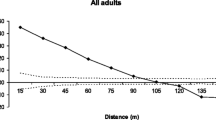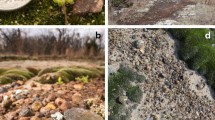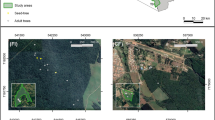Abstract
In order to understand the impacts of forest fragmentation on Araucaria angustifolia populations, we evaluated the genetic diversity and mating system using SSR markers and open-pollinated seeds from four populations of varying sizes and spatial isolation, in and around one of the best-conserved Araucaria Forest remnants in Southern Brazil. The four population types of A. angustifolia include: (1) a continuous forest; (2) a physically isolated cluster located 2 km from the continuous forest; (3) an open population in a field located between the cluster and continuous forest; and (4) a fragment on a private property located 5 km from the cluster. Approximately 28 seeds were collected from ten reproductive trees in each population. We found higher amounts of alleles (113) and exclusive alleles (25) in the continuous forest than in the other populations. The multilocus paternity correlation was significantly higher and effective number of pollen donors was significantly lower in the private population, decreasing the diversity and consequently the variance effective size of families sampled from that population. However, despite its isolation from the other studied fragments, the private population had the second highest number of alleles as well as unique alleles from the other populations. Therefore, strategies for A. angustifolia conservation should focus not only on larger populations, such as those found in protected areas, but also include smaller and isolated fragments on private properties as these populations are able to maintain high levels of genetic diversity and functional connectivity between isolated stands across a landscape.
Similar content being viewed by others
References
Bittencourt JVM, Sebbenn AM (2007) Patterns of pollen and seeds dispersal in a small, fragmented population of the wind pollinated tree Araucaria angustifolia in southern Brazil. Heredity 99:580–591
Bittencourt JVM, Sebbenn AM (2008) Pollen movement within a continuous forest of wind-pollinated Araucaria angustifolia, inferred from paternity and TwoGener analysis. Conserv Genet 9:855–868
Bittencourt JVM, Sebbenn AM (2009) Genetic effects of forest fragmentation in high-density Araucaria angustifolia populations in Southern Brazil. Tree Genet Genomes 5:573–582
Carvalho PER (2003) Espécies arbóreas brasileiras. Embrapa Informação Tecnológica e Embrapa Florestas, Brasília
Cockerham CC (1969) Variance of gene frequencies. Evolution 23:72–84
Danner MA, Ribeiro JZ, Zanette F, Bittencourt JVM, Sebbenn AM (2013) Impact of monoecy in the genetic structure of a predominately dioecious conifer species, Araucaria angustifolia (Bert.) O. Kuntze. Plant Syst Evol 299:949–958
Dean W (1996) A Ferro e Fogo: a História da Devastação da Mata Atlântica. Companhia das Letras, São Paulo
Ferreira DK, Nazareno AG, Mantovani A, Bittencourt R, Sebbenn AM, Reis MS (2012) Genetic analysis of 50-year old Brazilian pine (Araucaria angustifolia) plantations: implications for conservation planning. Conserv Genet 13:435–442
Goudet J (2002) Fstat (Version 2.9.3.2.): a computer program to calculate F-statistics. J Hered 86:485–486
Hamrick JL (2004) Response of forest trees to global environmental changes. For Ecol Manag 197:323–335
Jump AS, Penuelas J (2006) Genetic effects of chronic habitat fragmentation in a wind-pollinated tree. Proc Natl Acad Sci USA 103:8096–8100
Klein RM (1960) O aspecto dinâmico do Pinheiro do Paraná. Sellowia 12:17–44
Lacerda AEB, Kanashiro M, Sebbenn AM (2008) Long-pollen movement and deviation of random mating in a low-density continuous population of a tropical tree Hymenaea courbaril in the Brazilian Amazon. Biotropica 40:462–470
Lacerda AEB, Rosot MAD, Filho AF, Garrastazú MC, Nimmo ER, Kellermann B, Radomski MI, Beimgraben T, Mattos PP, Oliveira YMM (2012) Sustainable forest management in rural Southern Brazil: exploring participatory forest management planning. In: Martin-Garcia J , Diez JJ (eds.) Sustainable forest management—case studies, InTech, pp 97–118
Mantovani A, Morellato LPC, Reis MS (2006) Internal genetic structure and outcrossing rate in a natural population of Araucaria angustifolia (Bert.) O. Kuntze. J Hered 97:466–472
Mazza MCM, Bittencourt JVM (2000) Extração de DNA de tecido vegetal de Araucaria angustifolia (Araucariaceae). Bol Pesqui Florest 41:12–17
Medina-Macedo L, Lacerda AEB, Sebbenn AM, Ribeiro JZ, Soccol CR, Bittencourt JVM (2015a) High levels of genetic diversity through pollen flow of the coniferous Araucaria angustifolia: a landscape level study in Southern Brazil. Tree Genet Genomes 11(1):1–14
Medina-Macedo L, Lacerda AEB, Ribeiro JZ, Bittencourt JVM, Sebbenn AM (2015b) Investigating the Mendelian inheritance, genetic linkage, and genotypic disequilibrium for ten microsatellite loci of Araucaria angustifolia. Silvae Genet 63:234–239
Mittermeier RA, Gil PR, Hoffmann M, Pilgrim J, Brooks CMT, Lamoreux J, Fonseca GAB (2004) Hotspots revisted: earth’s biologically wealthiest and most threatened ecosystems. CEMEX, México DF, pp 99–103
Moraes MA, Gaino APS, Moraes MLT, Freitas MLM, Sebbenn AS (2012) Estimating coancestry within open-pollinated progenies of dioecious species: the case study of Myracrodruon urundeuva. Silvae Genet 61:256–264
Nason JD, Hamrick JL (1997) Reproductive and genetic consequences of forest fragmentation: two case studies of Neotropical canopy trees. J Hered 88:264–276
Nei M (1977) F-statistics and analysis of gene diversity in subdivided populations. Ann Hum Genet 41:225–233
Patreze CM, Tsai SM (2010) Intrapopulational genetic diversity of Araucaria angustifolia (Bertol.) Kuntze is different when assessed on the basis of chloroplast or nuclear markers. Plant Syst Evol 284:111–122
Reitz R, Klein RM (1966) Araucariáceas. Flora Ilustrada Catarinense
Ritland K (1989) Correlated matings in the partial selfer Mimulus guttatus. Evolution 43:848–859
Ritland K (2002) Extensions of models for the estimation of mating systems using n independent loci. Heredity 88:221–228
Sant’Anna CS, Sebbenn AM, Klabunde GHF, Bittencourt R, Nodari RO, Mantovani A, Reis MS (2013) Realized pollen and seed dispersal within a continuous population of the dioecious coniferous Brazilian pine [Araucaria angustifolia (Bertol.) Kuntze]. Conserv Genet 14:601–613
SAS Institute Inc. (1999) SAS procedures guide. Version 8 (TSMO). SAS, Cary, p 454
Sebbenn AM (2006) Sistemas de reprodução em espécies tropicais e suas implicações para a seleção de árvores matrizes para reflorestamentos ambientais. In: Higa AR, Silva LD (eds) Pomar de sementes de espécies florestais nativas. (Coord.). FUPEF, Curitiba, pp 93–138
Sebbenn AM, Carvalho ACM, Freitas MLM, Moraes SMB, Gaino APSC, Silva JM, Jolivet C, Moraes MLT (2011) Low levels of realized seed and pollen gene flow and strong spatial genetic structure in a small, isolated and fragmented population of the tropical tree Copaifera langsdorffii Desf. Heredity 106:134–145
Sork VL, Smouse PE (2006) Genetic analysis of landscape connectivity in tree populations. Landsc Ecol 21:821–836
Sousa VA, Hattemer HH (2003) Pollen dispersal and gene flow by pollen in Araucaria angustifolia. Aust J Bot 51:309–317
Sousa VA, Sebbenn AM, Hattemer H, Ziehe M (2005) Correlated mating in populations of a dioecious Brazilian conifer, Araucaria angustifolia (Bert.) O. Ktze. For Genet 12:107–119
Thomas P (2013) Araucaria angustifolia. The IUCN Red List of Threatened Species 2013: e.T32975A2829141. doi: 10.2305/IUCN.UK.2013-1.RLTS.T32975A2829141.en. Accessed 19 Sep 2015
Vibrans AC, Sevegnani L, Gasper ALD, Lingner DV (2013) Floresta Ombrófila Mista. Edifurb, Blumenau
White GM, Boshier DH, Powell W (1999) Genetic variation within a fragmented population of Swietenia humilis Zucc. Mol Ecol 8:1899–1909
Acknowledgments
The authors acknowledge the financial support provided by CNPq and CAPES as research fellowships to Luciano Medina-Macedo, Juliana Zanetti Ribeiro, Carlos Ricardo Soccol and Alexandre Magno Sebbenn. We also acknowledge the Brazilian Agriculture Research Corporation (EMBRAPA) for logistical and financial support and UFPR and UTFPR for providing the necessary infrastructure. Finally, we thank Dr. Evelyn Nimmo for editing the manuscript.
Author information
Authors and Affiliations
Corresponding author
Rights and permissions
About this article
Cite this article
Medina-Macedo, L., de Lacerda, A.E.B., Sebbenn, A.M. et al. Using genetic diversity and mating system parameters estimated from genetic markers to determine strategies for the conservation of Araucaria angustifolia (Bert.) O. Kuntze (Araucariaceae). Conserv Genet 17, 413–423 (2016). https://doi.org/10.1007/s10592-015-0793-2
Received:
Accepted:
Published:
Issue Date:
DOI: https://doi.org/10.1007/s10592-015-0793-2




